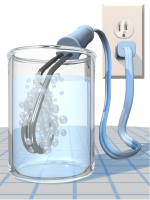|
 Have you ever accidentally touched a light bulb that was on for a long time? You may have burned your finger, because the bulb had heated up. Any resistive device—bulb or resistor—consumes power when a current flows through it. The power dissipated by a resistor is the product of the voltage drop V across it and the current I through it.
Have you ever accidentally touched a light bulb that was on for a long time? You may have burned your finger, because the bulb had heated up. Any resistive device—bulb or resistor—consumes power when a current flows through it. The power dissipated by a resistor is the product of the voltage drop V across it and the current I through it. 
|
| (17.5) | | | P | = | electrical power (W) | | I | = | electric current (A) | | V | = | voltage or potential difference (V) |
| Electrical power
in a circuit |
|
Power and electrical power are measured in watts (W). In forces and motion, we thought of one watt as one joule of energy per second. In electricity, one watt can also be considered to be one ampere of current across a voltage drop of one volt. 
|
In order to deliver 1,200 W of power for your microwave, the wires could deliver 1,200 A of current across 1 V or 10 A across 120 V. Since 1,200 A is a lot of current and would cause most wires to melt, home wiring systems typically use higher voltages (120 V) and carry smaller currents (10 A). 
 |
Your home’s electric bill lists charges for electricity by the kilowatt-hour, not the watt. As you will learn on page 496, the kilowatt-hour is power multiplied by time, which is a unit of energy, not power. Electrical utility companies are energy suppliers, not power suppliers! 
|
In many electrical circuits, you will connect a battery or voltage source across a resistor or lamp. You know the voltage V and the resistance R, but what is the power dissipated by the resistor? If you start with the power equation (17.5), you might realize that you don’t know the current I. Therefore you can use Ohm’s law I = V/R from equation (17.1) to substitute for I in the power equation: | | Electrical power
from voltage and resistance |
Similarly, if you know the current I and resistance R, you could substitute for V in the power equation (17.5) using the voltage drop version of Ohm’s law V = IR in equation (17.2): | | Electrical power
from current and resistance |

|
 A 1,000 W immersion heater runs off of the 120 V wall outlet. Will the current it draws trip a 20 A circuit breaker?
A 1,000 W immersion heater runs off of the 120 V wall outlet. Will the current it draws trip a 20 A circuit breaker? | Asked: | current I drawn by heater compared to 20 A | | Given: | power P = 1,000 W; voltage V = 120 V | | Relationships: | P = IV | | Solution: | Solve the equation for the unknown current I by dividing both sides by V: | | Answer: | The current is less than the 20 A maximum for the circuit breaker. The circuit breaker will not trip. | 
|

